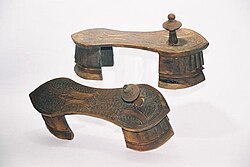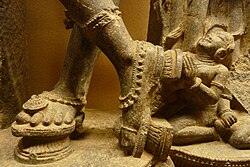
Back بادوكا Arabic খড়ম Bengali/Bangla Paduka French Paduka ID Paduka Italian ಪಾದುಕೆ KN മെതിയടി Malayalam ਪਾਦੁਕਾ PA Падука Russian பாதுகை Tamil

Paduka (Sanskrit: पादुक, romanized: pāduka) is an ancient form of footwear in India, consisting of a sole with a post and knob which is positioned between the big and second toe.[2] It has been historically worn in South Asia and Southeast Asia. Paduka exist in a variety of forms and materials. They might be made in the shape of actual feet, or of fish, for example, and have been made of wood, ivory and silver. They may be elaborately decorated, such as when used as part of a bride's trousseau, but could also be given as religious offerings or themselves be the object of veneration.[1]
Although simple wooden padukas could be worn by common people, padukas of fine teak, ebony and sandalwood, inlaid with ivory or wire, were a mark of the wearer's high status.[2] In the modern world, padukas are worn as footwear by mendicants and saints of Hinduism, Buddhism, and Jainism. Its significance in Hinduism is linked to the epic Ramayana. Paduka can also refer to the footprints of deities and saints that are venerated[3][4][5][6] in symbolic form in houses and purpose-built temples. One such temple is the Vishnupad Mandir in Gaya, India. Similarly, Buddha footprints are worshipped under the Bodhi Tree in Bodh Gaya.[6][7]
Paduka are the royal symbol in Malaysia. Seri Paduka denotes "His Majesty", which is a title bestowed as an honour of recognition to dignitaries of the Malaysian court.[8][9]

- ^ a b "britishmuseum.org".
- ^ a b "All About Shoes – The Bata Shoe Museum". Archived from the original on 29 December 2009. Retrieved 9 June 2009.
- ^ "The Paduka". Archived from the original on 29 December 2009. Retrieved 26 December 2009.
- ^ "Paduka". Fashion Encyclopedia. Archived from the original on 2 February 2010. Retrieved 26 December 2009.
{{cite web}}: CS1 maint: bot: original URL status unknown (link) - ^ "Feet and Footwear in the Indian Tradition". Archived from the original on 17 December 2009. Retrieved 26 December 2009.
- ^ a b Monier Monier-Williams. "Sanskrit Lexicon". p. 618. Retrieved 27 December 2009.
- ^ "In the Footsteps of the Divine". Archived from the original on 13 January 2010. Retrieved 26 December 2009.
- ^ Kampar (1969). Sri Paduka: the exile of the Prince of Ayodhya. Ohio University, Center for International Studies. pp. 3, 4. Retrieved 26 December 2009.
{{cite book}}:|work=ignored (help) - ^ Rigg, Jonathan (1862). A Dictionary of the Sunda language. Batavia, Java: Lange & Co.